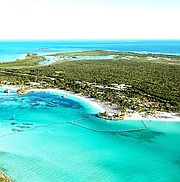By NEIL HARTNELL
Tribune Business Editor
nhartnell@tribunemedia.net
Environmental activists are challenging Disney Cruise Line to show how its Lighthouse Point project is “a fair deal for The Bahamas and people of South Eleuthera” via the economic returns each side gets.
Bahamian groups who form the Stop Disney - Last Chance for Lighthouse Point campaign, in feedback provided to the consultation on the cruise line’s Environmental Impact Assessment (EIA), called for the company to release the much-touted study by Oxford Economics on the project’s likely economic impact.
Pointing out that this study was conducted before COVID-19’s devastating impact on the Bahamian and world economies, and the cruise ship industry in particular, the environmental coalition argued that no data has been produced to support the headline numbers that were incorporated into the project’s Heads of Agreement with the government.
While the EIA asserts that Disney Cruise Line’s plan for Eleuthera’s southern tip “is conservatively expected to provide a $805m increase in Bahamian gross domestic product (GDP), and a $357.5m increase in Bahamian government revenues” over a 25-year period, the groups - as was also reported previously by this newspaper - said the figures are much less impressive on an annual basis.
“This amounts to an increase of only $32.2m in GDP and $14.3m increase in Bahamian government revenues per year,” the environmental coalition asserted.
“Disney is investing up to $400m in the development at Lighthouse Point. Every bed aboard a Disney ship represents around $237,000 in annual revenue. When multiplied by 3,500 passengers, Disney can expect to take in revenues of $830m per ship, per year.
“Disney needs to make clear exactly how this deal is fair to The Bahamas and the people of South Eleuthera. Disney has not released the 2018 Oxford Economics Study which supposedly substantiates their claims of economic benefits,” the groups added.
“To our knowledge, the only information that has been released is a very brief summary in the form of a powerpoint presentation which outlines takeaways, but does provide the underlying analyses (see Appendix).Disney needs to release the Oxford Economics study so stakeholders can fully assess the validity of the economic benefits Disney has promised.”
The “fair deal” assertion appeared regularly in the activists’ concerns and arguments against a project they remain firmly opposed to. Noting that Walt Disney’s 2019 full-year revenue amounted to $65.39bn, they added: “In contrast, the communities of South Eleuthera are in critical need of economic growth, experiencing unemployment rates as high as 70 percent to 80 percent.
“Lighthouse Point needs to be developed in a way that is both sustainable and equitable. The EIA should consider whether, in fact, the proposed development for Lighthouse Point is, in its current state, a fair deal for The Bahamas and South Eleuthera.
“As outlined in the above economics section, with the information that Disney has publicly released it is still unclear how the economic benefits to the communities of South Eleuthera will be even comparable to the company’s revenue from the port. In order to proceed responsibly and fairly, Disney must be explicit about how this deal is fair to The Bahamas and the people of South Eleuthera.”
The environmental activists also argued that GDP was the wrong indicator with which to measure the project’s impact, as it likely included revenues and passenger spending that were benefiting Disney Cruise Line and foreign vendors rather than Bahamian-owned businesses and their employees.
Arguing that gross national income would be a far better yardstick, they also questioned whether Disney Cruise Line’s project will provide continued access to Lighthouse Point for both stopover visitors and independent tour guides.
“The point at the Lighthouse Point site is a very popular attraction for stay-over tourists visiting the island in Governor’s Harbour or even as far up as Harbour Island,” the activists said. “These tourists frequently drive the length of the island to visit Lighthouse Point because of its pristine natural beauty. These tourists constitute a vital portion of the southern settlement’s income as they stop for gas, refreshments, souvenirs etc.
“Disney’s EIA must consider studies to examine how development of the port will impact the likelihood of stay-over tourists, who are known to contribute more to the economy of The Bahamas, visiting the site and contributing to local businesses along the way. It must also outline project costs to local businesses.”
And they added: “The EIA and the limited information we have received about the 2018 Oxford Economics study do not address potential costs to local business. The EIA states that ‘the developer will provide all citizens and residents of The Bahamas with full access to the property for non-commercial purposes’. This appears to exclude access to the area for independent local tour guides.
“Lighthouse Point is a major attraction for these businesses. At the April 8 Department of Environmental Planning and Protection (DEPP) public consultation, at minute 01:10:40, the question of whether or not local bird and other environmental guides would be able to bring their own customers on to the site [arose].
“Disney mentioned that they would hire Bahamians for their own shore excursions, but did not provide a clear answer as to whether or not local tour businesses would be able to operate independently at the site,” the activists continued.
“As it stands, Disney has the liberty to determine the number of tour operators with which they will collaborate, if any, and there are currently no limits on the rate of commission that Disney can charge. The EIA must include more specific information about their intentions for interacting with local business. It also must provide analyses of how their own operations will impact independent local businesses.”





Comments
Use the comment form below to begin a discussion about this content.
Sign in to comment
Or login with:
OpenID